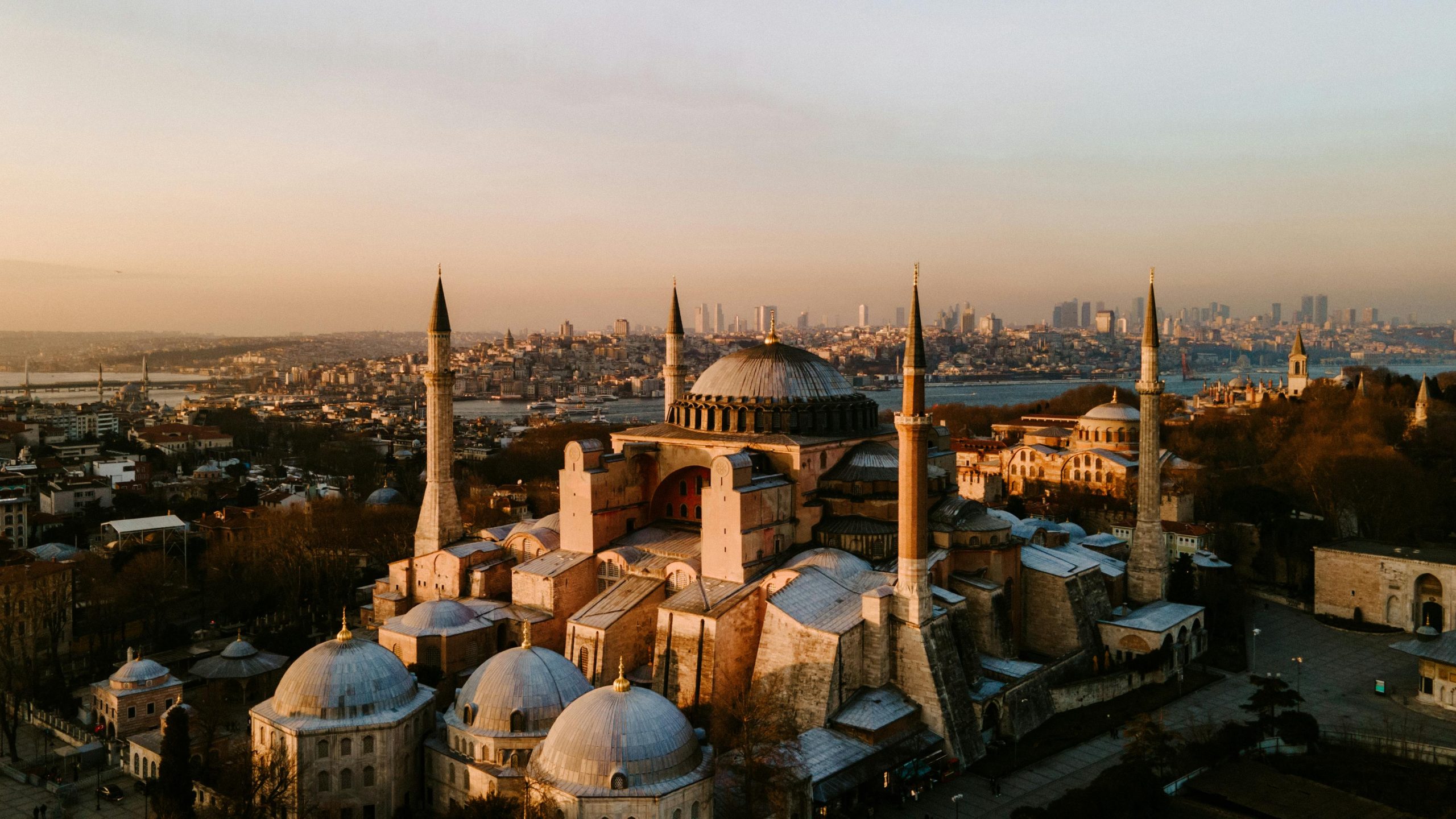Self-Guided Tour of the Walls of Constantinople (2025)
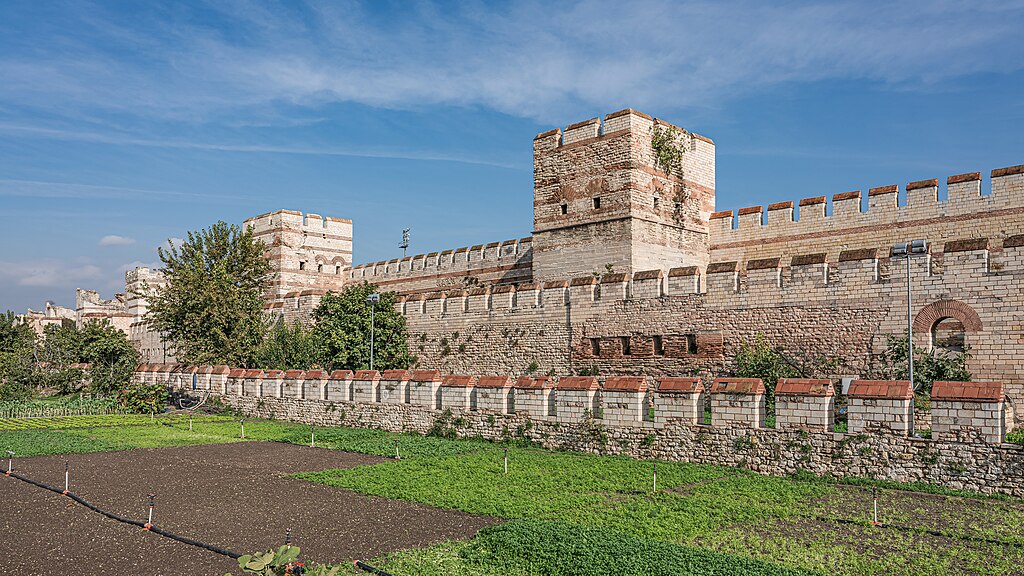
This website uses affiliate links which earn a small commission at no additional cost to you.
The Walls of Constantinople once stood as the ultimate symbol of power and endurance, protecting the Byzantine capital for more than a thousand years. Stretching from the Sea of Marmara to the Golden Horn, they made Constantinople virtually impregnable — a marvel of engineering and determination that shaped world history. Today, as you walk along their surviving stones, you trace the very line where empires rose and fell, and where the story of Istanbul truly began.
A Brief History of the Walls of Constantinople
The origins of Constantinople's mighty walls date back to the founding of the city itself. When Emperor Constantine the Great established his new capital in 324 CE, he enclosed it within a modest line of fortifications that stretched across what is now the old district of Istanbul. But as the city expanded and its prestige grew, so did the need for stronger defenses. The great transformation came under Emperor Theodosius II in the early 5th century, when engineers erected a new and far more ambitious system of walls that pushed the boundary several kilometers westward. Completed around 413 CE, this immense barrier — known as the Theodosian Walls — became the most formidable defensive structure of the medieval world.
Over the centuries, the walls endured relentless assaults. They withstood sieges by the Persians, Arabs, Bulgars, Rus', and Crusaders, surviving earthquakes and repairs alike. Byzantine emperors regularly restored them, most notably under the Emperor Anastasius and again after the devastating earthquakes of 447 CE, when the citizens of Constantinople reportedly rebuilt large sections in less than two months. Even during the city's final days in 1453, as Ottoman cannons pounded the walls, the defenses held longer than anyone had thought possible. Their eventual breach was not the result of weakness in design, but of a new era of warfare — gunpowder had rendered even the greatest walls vulnerable.
From the Golden Horn to the Sea of Marmara
The city's defensive network once extended for about 20 kilometers, enclosing the heart of Byzantine Constantinople in an immense arc of stone and brick. The most impressive section, the Theodosian Walls, ran across the landward side of the city from the Golden Horn in the north to the Sea of Marmara in the south. This stretch defined the western limit of the city and stood as its main bulwark against invading armies. Walking this line today, you follow a route that once separated the heart of empire from the vast and often hostile world beyond.
Features of the Theodosian Walls of Constantinople
The Theodosian Walls stretched for 5.7 kilometers (3.5 miles) between the Blachernae quarter near today's Ayvansaray and the Marmara coastline near the Tower of Basil and Constantine — better known as the Marble Tower. This extraordinary defensive line consisted of three main components: a deep moat, an outer wall, and an inner wall, together forming a system roughly 70 meters wide. Built in the early 5th century under Emperor Theodosius II, it represented the height of late Roman military engineering.
There were nine major gates and a number of smaller posterns, as well as 192 towers, alternating square and polygonal in design. The sheer scale of the system was astonishing — not only a defensive structure but a statement of imperial confidence. Even today, standing before these layered ramparts, you can sense the power they once projected.
The Inner Wall
Known to the Byzantines as the mega teichos or “great wall,” the inner wall was the city's principal line of defense. It measured between 4.5 and 6 meters thick and rose to about 12 meters in height, reinforced by 96 towers. These towers stood 15 to 20 meters high and 10 to 12 meters wide, each with two internal chambers and a battlemented terrace on top for archers and lookouts.
Many of the towers bore inscriptions marking repairs by later emperors, including inscriptions near the Gate of Saint Romanus (Topkapı). Today, a few of these towers — such as those near the Xylokerkos Gate (Belgrad Kapısı) — still show traces of their original inscriptions and brickwork. Standing beneath them, it's easy to imagine the defenders who once patrolled their heights, watching for the glint of enemy standards on the horizon.
The Outer Wall
The outer wall, or exo teichos, stood roughly 15 meters in front of the inner wall, separated by a wide terrace. Though smaller, it played a vital role as the second line of defense, measuring about 2 meters thick and 8.5 to 9 meters high. Like the inner wall, it was punctuated by 96 towers, 12 to 14 meters high, of which around 62 survive today.
In battle, the outer wall's parapet provided cover for archers while the space between the walls allowed for quick troop movement. The towers near Belgrad Kapısı and Silivri Kapısı still show how the outer wall connected seamlessly with the main system, forming a continuous barrier that once seemed unbreakable.
The Terraces
Between the inner and outer walls lay the peribolos, a terrace 15 to 20 meters wide that served as a staging area during sieges. Soldiers could regroup here or launch counterattacks through the gates above. Beyond this, the exo parateichion — another terrace about 15 meters wide — ran between the outer wall and the moat. This space included a paved road used by soldiers and supply carts, ensuring swift reinforcement during battles.
Today, much of these terraces are covered by gardens or open ground, but in many places their outlines are still visible. The sections south of Belgrad Kapısı are particularly atmospheric, with their wide grassy spaces hinting at the scale of the original defenses.
The Moat
The moat, known as the souda, completed the system. It stretched about 20 meters across and up to 10 meters deep, with a 1.5-meter-high retaining wall on its inner edge that served as the first line of defense. In times of war, the moat could be flooded from nearby streams, turning the approach to the walls into a deadly trap.
Over the centuries, as sieges faded into memory, the moat's fertile soil became farmland. Even today, small gardens thrive here, especially near the Gate of Rhegion (Yeni Mevlevihane Kapısı) and the Gate of the Spring (Silivri Kapısı), where locals cultivate vegetables much as their ancestors have for centuries. Walking past these green spaces, framed by crumbling towers and ancient stone, you see how the old defenses of Constantinople have become part of Istanbul's living landscape.
The Later Blachernae and Sea Walls
To the northwest, the Blachernae Walls formed a separate but connected fortification zone, built between the 10th and 12th centuries to protect the imperial palace complex near today's Ayvansaray. These walls were thicker and more irregular than the Theodosian section, following the natural slopes toward the Golden Horn. Their towers and bastions reflect the changing military architecture of Byzantium's final centuries.
Meanwhile, the Sea Walls stretched along both the Marmara coast and the Golden Horn, standing about 8 meters high and forming a single defensive line. They were supported by the Byzantine navy and guarded the harbors, docks, and merchant quays that lined the water's edge. Although much of the sea wall system has vanished beneath modern roads and buildings, fragments remain near Sarayburnu and Yenikapı, offering quiet reminders of a time when Constantinople was as secure from the sea as it was from land.
How to Get There
It would be slightly better to begin your walk at the southern end of the city walls, near Kazlıçeşme İstasyonu on the Marmaray rail line, which provides easy access to the most impressive and best-preserved stretches of the Theodosian Walls. From here, it's a short stroll to the Yedikule Fortress and the Marble Tower, the perfect place to start your journey along the fortifications. If you prefer, you can also take a taxi directly to Yedikule to save time.
At the end of the walk you will be at the Golden Horn at Haliç Parkı and the Ayvansaray Ferry Stop.
If it's too hot to walk it all, condifer starting at the Panorama 1453 History Museum and head south along the wall. The easiest way to reach it is by taking the T1 Tram Line to Topkapı station, which stops just outside the museum entrance.
Theodosian Walls Visitor Centres
Several new visitor centres now make exploring the Theodosian Walls of Constantinople far more accessible and rewarding. You'll find them at Mevlanakapı, near the Gate of Rhegion; Silivrikapı, beside the Gate of the Spring; and Belgradkapı, next to the Xylokerkos Gate. Opened in recent years, these small, well-designed centres serve as excellent starting points or rest stops along the route. Inside, you'll discover clear exhibits explaining the construction of the walls — from the moat and terraces to the inner and outer defenses — along with maps, rest areas, and sometimes cafés. The Belgradkapı centre even features a small library and an elevated walkway that lets visitors enjoy panoramic views over the ramparts.
For anyone walking the Byzantine Walls, these centres are invaluable. They bring the ruins to life where interpretation might otherwise be difficult, helping you visualize the city's once-formidable defenses. Each one serves as a practical waypoint for a short break or orientation before continuing north toward Edirnekapı or south toward Yedikule Fortress. Whether you pause to study the architectural details, admire the restored towers, or simply enjoy a coffee with a view, stopping at one of these centres adds both insight and comfort to your journey — a seamless blend of history, learning, and modern accessibility.
Walking the Byzantine Walls
The full route from the Golden Gate in the south to the Gate of Charisius in the north covers about 7 kilometers (4.3 miles) and takes roughly two hours on foot. It is largely exposed to the elements, so bring water and sun protection, especially in summer. Begin your walk from Ayvansaray Ferry Stop at the Golden Horn or from Kazlıçeşme Station near the Sea of Marmara. Along the way, you will pass neighborhoods that blend history with everyday life—markets, mosques, workshops, and cafés tucked between stretches of ancient masonry.
1. The Marble Tower
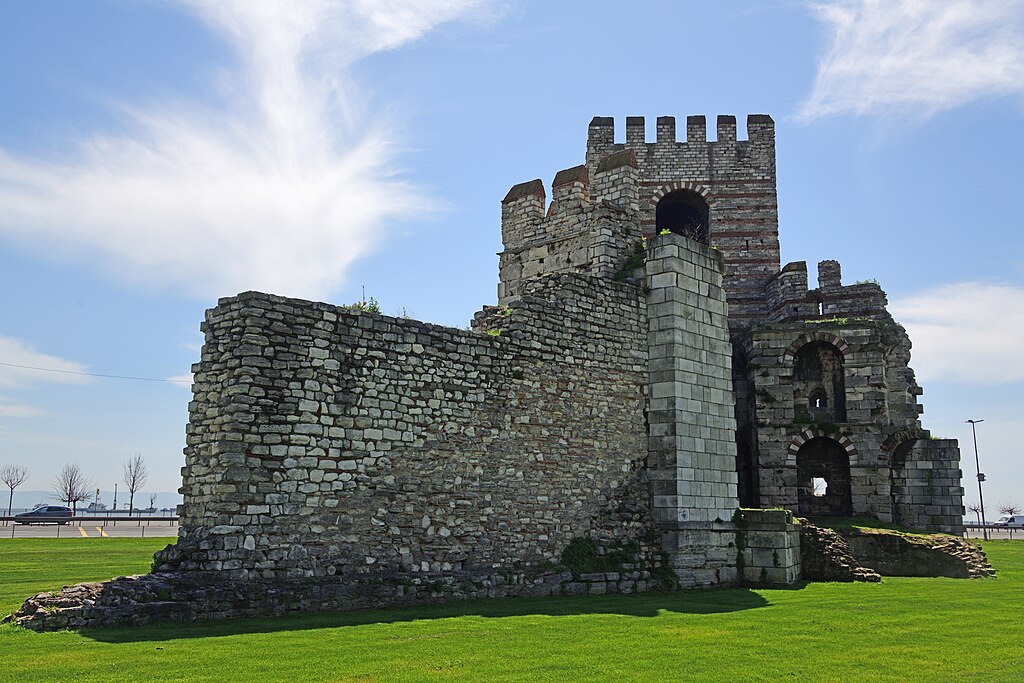
Begin your journey at the Marble Tower (Mermer Kule), a striking remnant at the southernmost corner of the old city walls, where the Theodosian land defenses meet the sea walls of the Marmara. This tower, built of recycled marble blocks from ancient monuments, is one of the last visible points where you can see the full transition from land to sea fortifications. It feels far removed from the bustle of central Istanbul — the sound of waves on one side, and the great expanse of stonework stretching inland on the other. The white marble glints faintly in the morning sun, hinting at a time when Constantinople gleamed with imperial splendor.
The area around the Marble Tower is calm, with small local parks and gardens that have grown over what was once a strategic military junction. Standing here, you can sense how vital this corner was to the city’s defense — a literal meeting of empire and sea. It’s a fitting place to start, grounding the walk in both geography and history. From here, follow the direction of the walls inland, keeping the high battlements to your right as you make your way toward Yedikule Fortress.
Location: Marble Tower, İçi Yolları, Yedikule, Koca Mustafa Paşa Parkı, Fatih/İstanbul, Türkiye
Read more about Marble Tower
2. Golden Gate & Yedikule Fortress
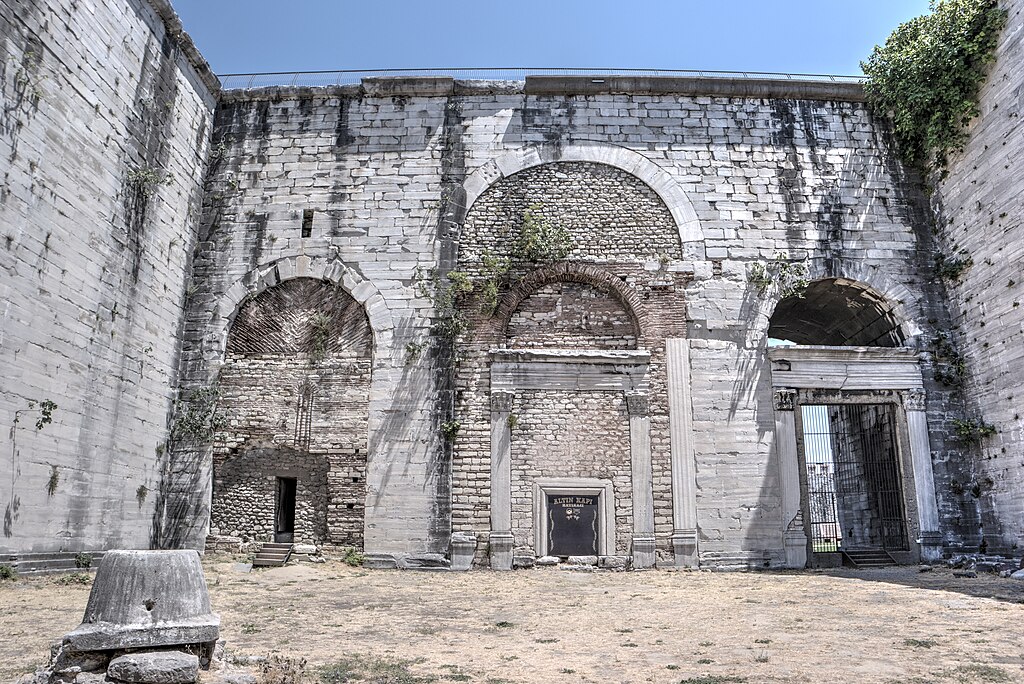
Golden Gate also known as Xerolophos Gate, Gate of Saturninus, İsakapı (“Gate of Jesus”), later Yedikule Fortress or Fortress of the Seven Towers
At the southern end of the Theodosian Walls, where the fortifications meet the Sea of Marmara, stands one of the most impressive and symbolic sites in Istanbul — the Golden Gate, later enclosed within the mighty Yedikule Fortress. What was once the ceremonial heart of imperial Byzantium became, centuries later, a fortress-prison under the Ottomans, a transformation that perfectly captures the city’s long passage from Roman capital to Ottoman stronghold.
The Golden Gate (Porta Aurea) was the grandest of Constantinople’s entrances, built in the early 5th century as part of Emperor Theodosius II’s new wall system. Clad in gleaming white marble and topped with gilded bronze statues, it was not a military gate but a triumphal arch — the symbolic entry point for victorious emperors returning from campaigns. Inscriptions once proclaimed, “Theodosius adorns the city with gold,” a fitting tribute to the gate’s opulence. Contemporary accounts describe its triple-arched form flanked by massive square towers, through which imperial processions entered the city amid fanfare, incense, and cheering crowds. The Golden Gate was also used in religious festivals and coronation ceremonies, serving as a potent emblem of divine kingship.
By the late Byzantine period, the gate had lost its ceremonial function. Earthquakes and sieges took their toll, and by the time of the Ottoman conquest in 1453, it was a weathered monument at the edge of a shrinking empire. Sultan Mehmed II, recognizing both its symbolic power and its strategic position, ordered the construction of Yedikule Hisarı, the Fortress of the Seven Towers, around the old gate in 1458. The new fortress incorporated the two original Byzantine towers of the Golden Gate and added five massive Ottoman towers to form a pentagonal stronghold connected by thick curtain walls. Within its enclosure, the Ottomans created a secure treasury and later a grim state prison. Foreign ambassadors who fell out of favor, rebellious governors, and even Ottoman princes were imprisoned or executed here. The fortress’s blend of Byzantine marble and Ottoman brick gives it a haunting beauty — a place where two empires meet in stone.
Today, Yedikule Fortress stands as one of the most atmospheric places to visit along the ancient walls. Its massive towers rise above quiet residential streets, the sea shimmering beyond. Visitors can enter through the main gate and climb the battlements for sweeping views over the Marmara and the long line of the Theodosian Walls stretching northward. Inside, the courtyard is vast and empty, ringed by towers that echo with the cries of gulls. Some sections of the old Golden Gate remain clearly visible — the marble blocks weathered but distinct, a ghost of imperial grandeur within an Ottoman shell. Early morning is the best time to visit, when light slants across the stone and the crowds are few. Standing atop the ramparts, you can look out over the same horizon once guarded by emperors and sultans alike, feeling how history here is layered and alive.
Location: Golden Gate, Yedikule, Fatih/İstanbul, Türkiye | Hours: The gate can be viewed at all times; fortress hours vary. | Price: Free
Read more about Golden Gate
3. Xylokerkos Gate
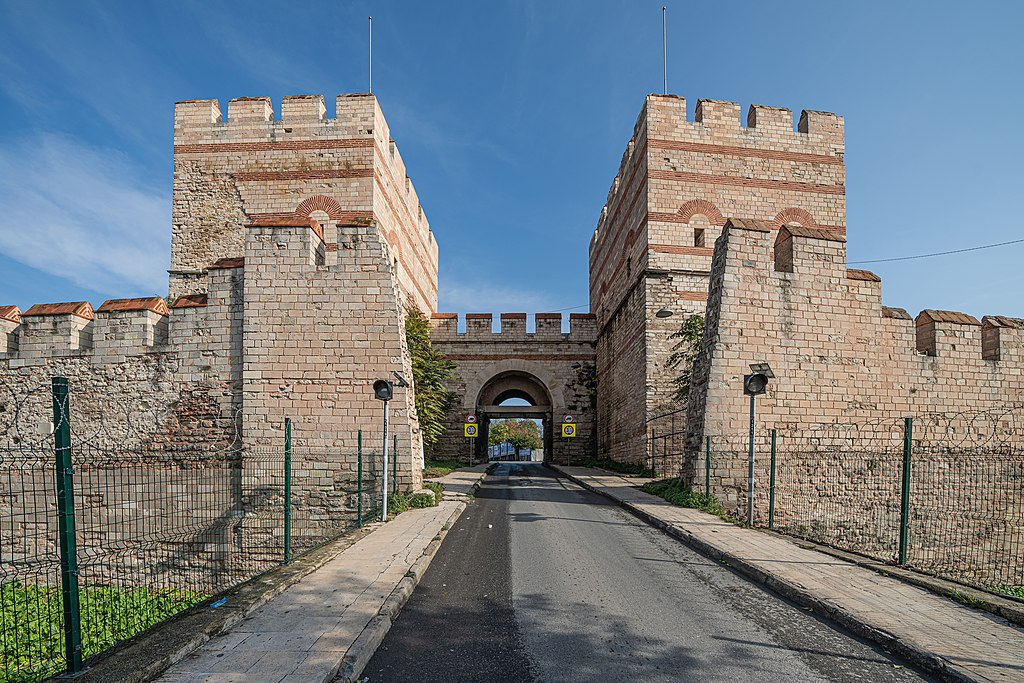
Xylokerkos Gate also known as the Gate of Belgrade
The Xylokerkos Gate, lies between towers 22 and 23 and carries a history steeped in prophecy and superstition. Its Greek name, meaning “Wooden Circus Gate,” hints at an ancient amphitheater or wooden structure that once stood beyond the walls. Unlike the ceremonial Golden Gate, this entrance served practical and defensive purposes, opening onto the outer regions of the city. It was here, in 1189, that Emperor Isaac II Angelos ordered the gate sealed after a prophecy warned that Emperor Frederick Barbarossa would enter through it—an act meant to forestall fate itself.
For centuries afterward, the gate remained closed, earning its Ottoman name Kapalı Kapı, the “Closed Gate.” Only in 1346 was it reopened, later gaining the title Belgrade Gate after prisoners from Belgrade were settled nearby following the Ottoman conquest of Serbia. Through its repeated closings and reopenings, the Xylokerkos Gate became a powerful symbol of the city’s fears, hopes, and resilience—a threshold that Byzantium seemed both to guard and to fear. Each layer of its history reflects how the city adapted its defenses and legends to shifting political and spiritual tides.
Visitors today can still see the structure’s imposing dimensions—nearly 20 meters high and 12 meters wide—and the traces of restoration that kept it standing. The towers beside it rise above a landscape that has changed utterly, yet their massive stones preserve a sense of continuity. Climbing the steps beside the gate reveals views of the neighborhoods beyond, blending modern Istanbul with its ancient backbone. Standing atop these towers, you can almost sense the echo of soldiers once stationed here, watching the plains beyond for signs of siege.
Location: Belgrade Gate, Sümbül Efendi, Fatih/İstanbul, Türkiye
Read more about Xylokerkos Gate
4. Gate of Spring

Also known as the Pege Gate, Gate of Selymbria (Modern Turkish)
The Gate of the Spring derives its name from the nearby monastery of Zoodochos Pege (“Life-Giving Spring”) in Balıklı, famed for its holy waters. This association made the gate not only a defensive feature but also a spiritual landmark for Byzantines. Its twin heptagonal towers were extensively rebuilt during the empire’s later years, with one bearing an inscription from 1439 commemorating Emperor John VIII Palaiologos. These details evoke a sense of continuity—how, even in its final century, Byzantium invested care and devotion into preserving its sacred and strategic architecture.
The Pege Gate played a crucial role in one of Constantinople’s most dramatic reversals of fortune. In July 1261, General Alexios Strategopoulos, leading troops of the Empire of Nicaea, approached the city after hearing that the Latin garrison and Venetian fleet were away raiding. Entering secretly through the Pege Gate, his men surprised the guards, opened the walls from within, and retook Constantinople from the Latin occupiers. This victory restored the Byzantine Empire after decades of exile, and Emperor Michael VIII Palaiologos entered the city triumphantly soon after. Few gates in the city’s walls can claim such a pivotal moment in history.
Standing before the Gate of the Spring today, it is easy to forget that this quiet corner once witnessed the resurrection of an empire. The surrounding suburb, filled with small houses and gardens, belies the site’s former significance. Yet beneath its stones lie the remains of earlier reliefs and tombs—silent witnesses to centuries of faith and warfare. The name “Life-Giving Spring” feels apt even now, for it was through this gate that Byzantium itself found new life.
Location: Silivrikapı, Hisaraltı Cd. No:1, 34107 Fatih/İstanbul, Türkiye
Read more about Gate of the Spring
5. Gate of Rhesios
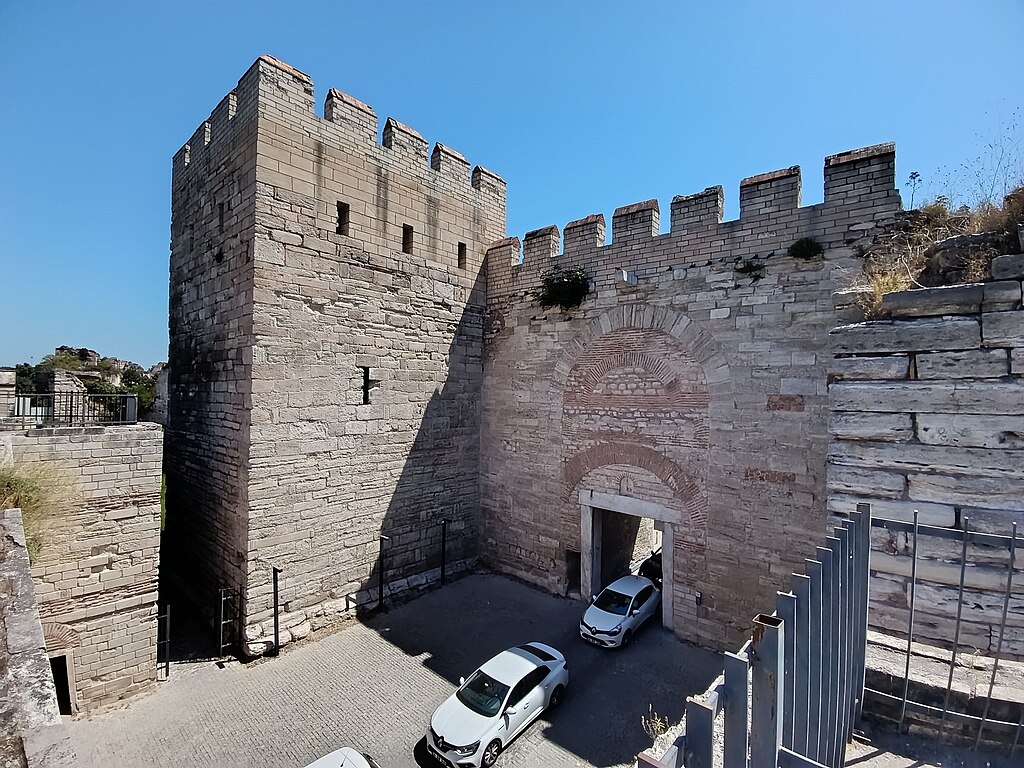
Also known as Gate of Rhegion, Gate of Rhousios
The Gate of Rhesios stands as one of the best-preserved sections of the Theodosian Walls, maintaining much of its 5th-century form. It takes its name from a general or noble associated with early Byzantium, though later records call it the Gate of Rhegion, after the nearby suburb. Its towers are impressive in scale and notable for their inscriptions—more than any other gate in the wall. These carved messages celebrated emperors and divine protection, blending religion and statecraft into stone. The phrase “The Fortune of Constantine, Our God-Protected Despot, Triumphs” still echoes from its worn blocks, a defiant declaration of the empire’s divine mandate.
Throughout its long history, the Gate of Rhesios stood firm through sieges that battered lesser sections of the wall. Its careful masonry and balanced design testify to the precision of the Theodosian engineers, who created a defense system far ahead of its time. The gate also reveals the Byzantine obsession with symbolism and inscription; every carved phrase, every reused block of marble, carried a meaning meant to inspire and protect. To pass through the Rhesios Gate was to move under the watch of heaven and empire alike.
For today’s visitor, this gate offers a glimpse of Byzantium at its most confident—faith in architecture, faith in God, and faith in destiny. The area around it remains largely unfrequented by tourists, lending a stillness that enhances its aura. Standing here, with the ancient stonework rising on either side, you can feel the continuity between the spiritual and military life of Constantinople. The walls were not just barriers; they were monuments to a worldview in which divine order and human engineering intertwined.
Location: Mevlânakapı Kapısı, Mevlanakapı, Mevlanakapı Caddesi, Fatih/İstanbul, Türkiye
Read more about Gate of Rhesios
6. Panorama 1453 History Museum

As you make your way along the Theodosian Walls, the Panorama 1453 History Museum is an essential stop to truly grasp the drama of what took place here more than five centuries ago. Standing just beside the stretch of wall where Sultan Mehmed II’s cannons shattered Constantinople’s defenses, the museum immerses you in the final days of the Byzantine Empire. Inside, a vast 360-degree painting recreates the siege in astonishing detail — soldiers charging, smoke rising, drums pounding — all enhanced by sound and light effects that make the scene feel alive. It’s an emotional and atmospheric experience, especially when you step outside and see the very stones that once bore witness to the real event.
Visiting Panorama 1453 midway through your wall walk helps bridge imagination and reality. It provides invaluable context, connecting the ruins you’ve been tracing to the moment that defined their fate. Many walking tours of the Byzantine walls pause here, not just for the museum’s exhibits but for a chance to rest, reflect, and see the story from both sides of the conflict. Whether you spend half an hour or linger longer, the museum adds depth to your journey — a reminder that these weathered walls were once the front line of a world-changing struggle.
Location: Panorama 1453 History Museum, Merkez Efendi Mahallesi, Topkapı Kültür Park İçi Yolu, Zeytinburnu/İstanbul, Türkiye
Read more about Panorama 1453 History Museum
7. Gate of Saint Romanus
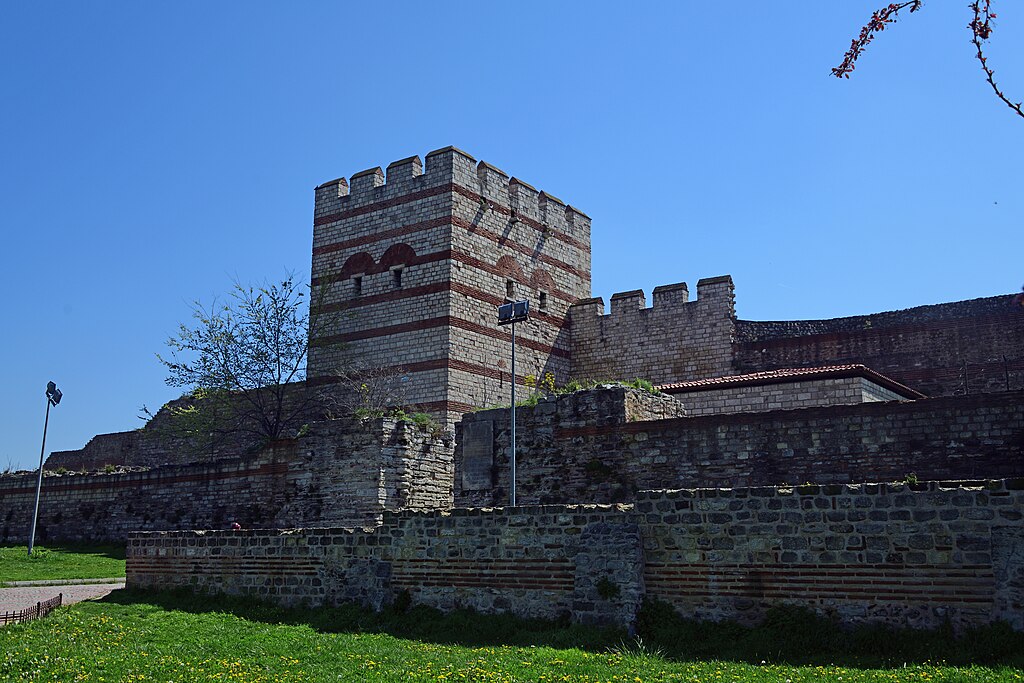
Also known as Topkapı or “Cannon Gate.”
Few places along the Theodosian Walls carry as much drama as the Gate of Saint Romanus. It was here, in May 1453, that the fate of Byzantium was sealed. The gate took its name from a nearby church and occupied a commanding position along the Seventh Hill. During the city’s final siege, Emperor Constantine XI established his command post here, knowing it would bear the brunt of the Ottoman assault. The defenders mounted the great cannon “Basilic” opposite the gate, a desperate attempt to counter the enemy’s firepower. The thunder of those guns marked the dying heartbeat of an empire that had stood for over a thousand years.
For weeks, the defenders held their ground against overwhelming odds, repairing breaches by night and fighting by day. When the walls finally gave way on 29 May 1453, it was near this gate that the final stand occurred. Chroniclers wrote of chaos and heroism as the last emperor fell among his soldiers, sword in hand, refusing to abandon his city. Through this gateway poured the forces of Sultan Mehmed II, claiming Constantinople for the Ottoman Empire and transforming the course of history. The event signaled not just the end of Byzantium but the beginning of a new world order.
Modern Istanbul has grown around this site, and the hum of traffic now replaces the clash of arms. Yet for those who pause to reflect, the Gate of Saint Romanus remains one of the city’s most sacred spaces—a memorial to courage, faith, and final defeat. It embodies both the glory and tragedy of Constantinople’s long defense, marking the precise spot where empire met its destiny.
Location: Topkapı, Fatih/İstanbul, Türkiye
Read more about Gate of Saint Romanus
8. Fifth Military Gate

Also known as the Water Tower Gate, Hücum Kapısı, or “Assault Gate”
The Fifth Military Gate, situated just north of the valley of the Lycus River, played a more utilitarian but no less vital role in the city’s defense. Known as the Pempton (“the Fifth”) , it served as a key logistical entry for troops and supplies, connecting the defensive corridors of the Theodosian Walls. Although its structure today is heavily damaged, scholars believe that this was the precise location of the Ottoman breakthrough during the final assault of 1453. The Turkish name Hücum Kapısı, or “Assault Gate,” preserves the memory of that devastating morning.
Accounts from the siege describe waves of Ottoman soldiers swarming this section of the wall at dawn. The Byzantines, exhausted and outnumbered, struggled to hold their ground. When the walls finally gave way, the breach opened a path straight into the heart of the city. Some traditions suggest that Emperor Constantine XI perished nearby, making this one of the most poignant locations along the entire wall. The area’s strategic weakness—the narrow valley and eroded foundations—proved fatal to the city’s last defense.
Today, visitors standing among the ruins can imagine the tumult that once filled this place. The broken stones bear the silent imprint of battle, while the surrounding greenery softens the memory of destruction. The contrast between the peaceful modern landscape and the violent history beneath it lends the site an almost sacred stillness. Here, history is written not in words but in the fractured lines of the wall itself—a testament to the endurance and final fall of the Byzantine world.
Location: Topkapı, Sulukule Caddesi, Fatih/İstanbul, Türkiye
Read more about Fifth Military Gate
9. Gate of Charisius
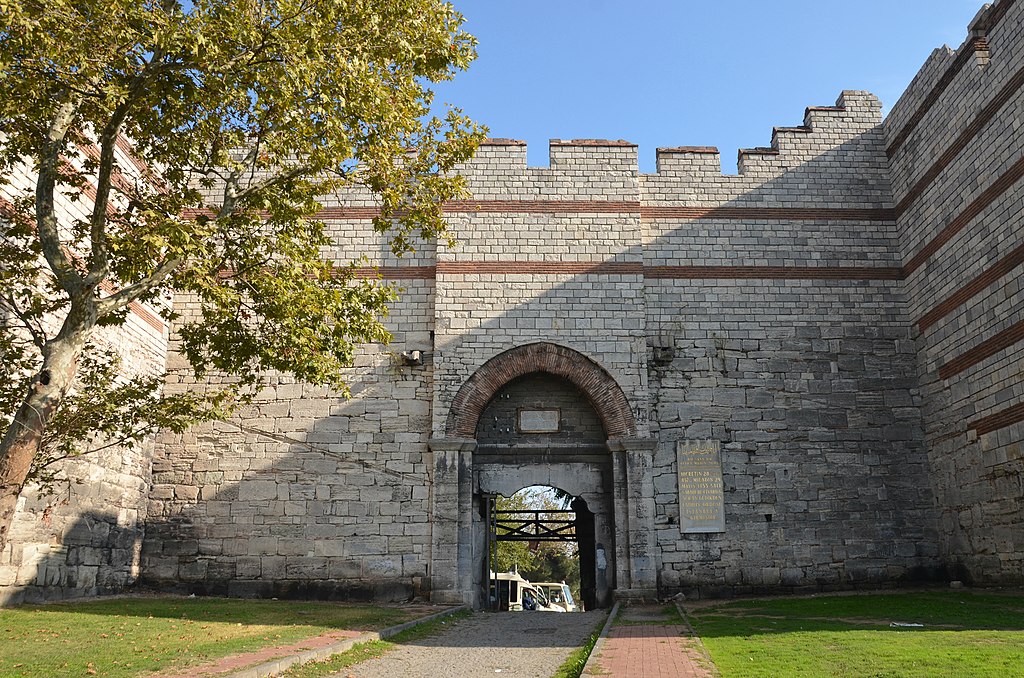
The Gate of Charisius, also called the Adrianople Gate, crowns the highest of Istanbul’s seven hills and serves as the northern terminus of the land walls. Second in importance only to the Golden Gate, it was one of the principal entrances into the city and a vital stronghold during sieges. Its elevated position offered commanding views of both the Golden Horn and the surrounding countryside, making it a favored location for defense. Yet its fame rests on the events of 1453, when the victorious Mehmed II entered Constantinople through this gate, marking the city’s transformation into the capital of the Ottoman Empire.
This symbolic entry was more than a military act—it was the fulfillment of destiny. After centuries of failed sieges, the Ottomans had finally achieved what countless others could not. Mehmed’s entrance through the Charisius Gate was carefully choreographed, echoing the imperial triumphs of the Byzantine emperors he replaced. In that moment, Constantinople became Istanbul, and the continuity of empire—Roman to Byzantine to Ottoman—was sealed. Ten years later, Mehmed II’s visit to the ruins of Troy would link his conquest to ancient legend, as he claimed to avenge the Trojans by defeating the Greeks.
The Gate of Charisius is not merely an architectural relic; it is a living testament to the cyclical nature of history. From this vantage point, with the Golden Horn glinting in the distance, the story of Constantinople comes full circle—its triumphs and tragedies carved eternally into stone.
Location: Edirnekapı, Dervişali, Fatih/İstanbul, Türkiye
Read more about Gate of Charisius
10. Palace of the Porphyrogenitus
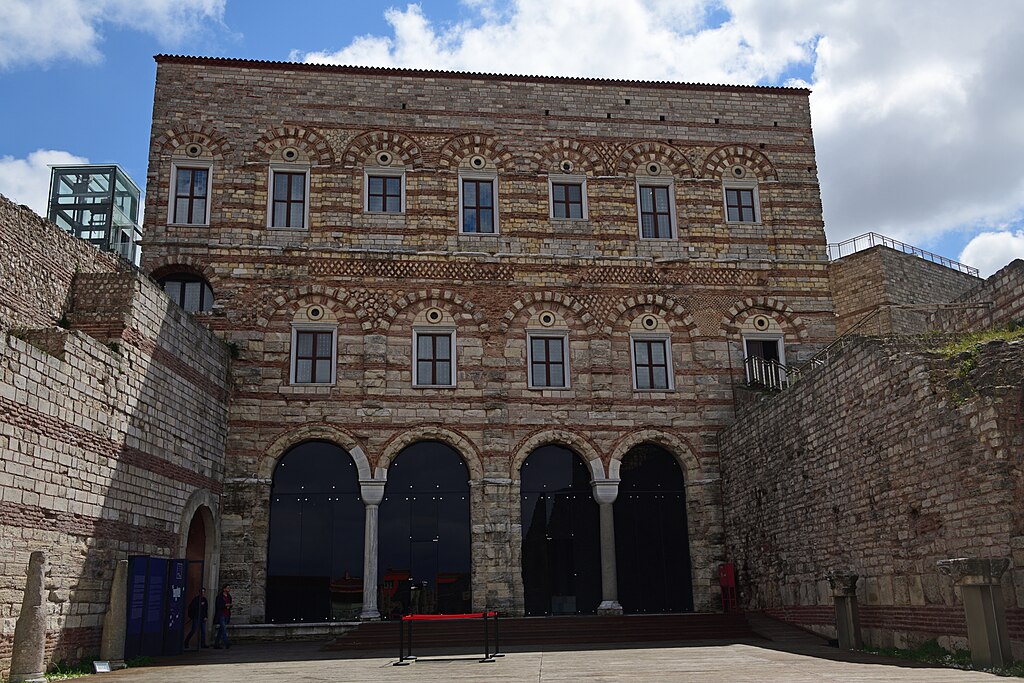
The Palace of the Porphyrogenitus, also known as Tekfur Sarayı, stands as the last surviving fragment of the once vast Blachernae Palace complex in northwestern Constantinople. Built in the late 13th or early 14th century during the reign of the Palaiologos dynasty, it served as an imperial residence for members of the royal family—possibly for princes bearing the title Porphyrogenitus, meaning “born in the purple.” Its position against the inner face of the Theodosian Walls gave it both protection and prestige, symbolising the intertwining of imperial authority and the city’s defenses. From its balconies, Byzantine rulers could look out over the Golden Horn and the northern suburbs, a view that once encompassed the lifeblood of the capital.
The palace is one of the few examples of Byzantine secular architecture still standing in Istanbul, and its striking façade of alternating red brick and white limestone remains remarkably intact. Three stories tall, it once featured a grand hall, private apartments, and ceremonial chambers connected to the greater Blachernae complex by covered passages. After the Ottoman conquest in 1453, the palace found new life as a glass workshop and later as a ceramics factory that produced tiles for nearby mosques and palaces, including Topkapı. Though its imperial splendor faded, its strong walls and adaptable design allowed it to survive centuries of change, standing as a bridge between the Byzantine and Ottoman worlds.
For visitors walking the line of Constantinople’s ancient walls, the Palace of the Porphyrogenitus is a captivating stop—a place where the grandeur of empire lingers in the quiet air. Its restored interior now houses exhibitions on the site’s layered history, while the upper levels offer views across the surrounding Ayvansaray district. It is both a physical and symbolic endpoint to the Byzantine story, embodying the resilience of a civilization that once ruled the Mediterranean. For anyone tracing the city’s fortifications, this palace is a highlight of any walking tour of Istanbul, revealing how power, art, and endurance came together in the shadow of the city’s mighty walls.
Location: Palace of the Porphyrogenitus, Ayvansaray, Fatih/İstanbul, Türkiye
Read more about Palace of the Porphyrogenitus
11. Gate of the Bootmakers’ Quarters

The Kaligaria Gate, also known as the Gate of the Bootmakers’ Quarters, was one of the lesser-known but historically significant entrances in the Byzantine Walls of Constantinople. Its name, derived from the Greek kaligarios meaning “bootmaker,” reflects the nearby craftsmen’s district that once supplied the imperial army and city dwellers with sturdy footwear. Located near the great Blachernae Palace complex in the northwest corner of the city, the Kaligaria Gate served as a practical access point between the imperial quarters and the surrounding neighbourhoods. Unlike the grand ceremonial gateways of the southern walls, this was a working gate, used daily by artisans, soldiers, and servants who sustained the rhythms of life behind Constantinople’s mighty fortifications.
During the later Byzantine period, when the Blachernae area became the main seat of imperial power, the Kaligaria Gate took on added importance. It provided a discreet link between the palace precincts and the city beyond, allowing controlled passage for those serving the emperor’s household. Because of its proximity to both the Blachernae Palace and the Palace of the Porphyrogenitus, it would have seen a steady stream of courtiers, craftsmen, and guards moving between the political and domestic heart of the empire. The gate’s modest size and utilitarian design contrast sharply with the monumental Golden Gate at the opposite end of the walls, yet together they illustrate the range of roles the city’s entrances played—from grand triumphal processions to the daily functions of an imperial capital.
Today, only traces of the Kaligaria Gate remain, but its location still offers a fascinating insight into the organization of late Byzantine Constantinople. For visitors tracing the route of the old land walls, it marks the transition between the ceremonial and residential zones of the city’s fortifications. Standing here, one can imagine the bustle of workers, soldiers, and traders passing in and out beneath its arch, unaware that their everyday routines were unfolding in the shadow of the empire’s final centuries. The Kaligaria Gate may not boast the grandeur of better-known portals, but it remains one of the best places to see how the walls of Constantinople once balanced imperial majesty with the hum of ordinary life.
Location: Eğrikapı, Ayvansaray, Eğrikapı Cd., Fatih/İstanbul, Türkiye
Read more about Kaligaria Gate

Moira & Andy
Hey! We're Moira & Andy. From hiking the Camino to trips around Europe in Bert our campervan — we've been traveling together since retirement in 2020!
This website uses affiliate links which earn a small commission at no additional cost to you.
Walking Tour Summary
Distance: 8.5 km
Sites: 11
